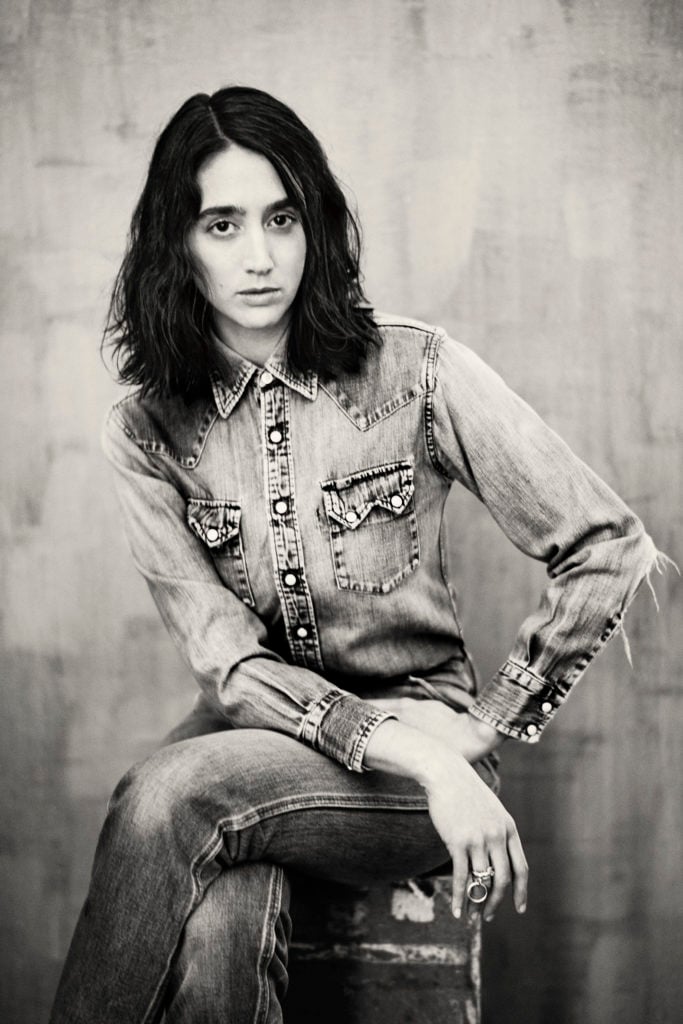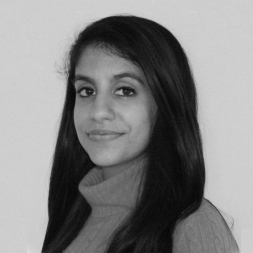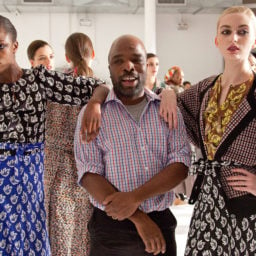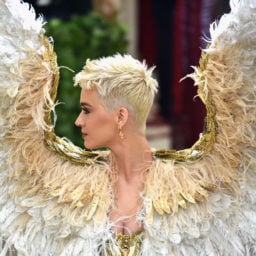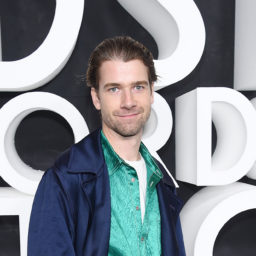Natacha Ramsay-Levi, the creative director of Chloé, has long supported the work of independent artists, pulling them into the sweetly bohemian world of the heritage French house for collaborations that have imbued her collections with bold patterns, dazzling prints, and, as fashion critic Tim Blanks noted during her debut show, “a slightly eerie edge.”
In the three years since she joined the house, Ramsay-Levi has continued to explore the bounds of fashion through adjacent creative forms, incorporating nods to the visual arts, cinema, literature, and dance.
We recently spoke to the designer about why she enjoys working with creatives across disciplines, what defines a successful art-fashion collaboration, and her broader predictions for the future of Chloé as the industry adapts to a new reality.
What drew you to Chloé as a house?
It’s funny because though I love style, to me, Chloé is a brand that exists a little outside of fashion in the sense that it’s not a house in which you expect things to be reinvented all the time. It’s a brand that talks about the zeitgeist, to some extent, but through its particular attitude and sensibility. I joined the house because it gathers many values and inspirations that I felt connected to. The Chloé sensibility is a way of being in the world, and it represents the spirit of the kind of woman that I feel close to. And Chloé gave me the opportunity to work with artists who I have loved and followed for years.
You’ve worked with several visual artists at Chloé, from Rita Ackermann to Rithika Merchant to Marion Verboom. You’ve also worked with other creatives, like musician Marianne Faithfull. In a sense, these collaborations have become part of your indelible mark as creative director there. Why bring in art and artists?
The work of a creative director is different now than it used to be—before we were called “designers,” which I think meant something much more singular. Now there’s a slightly broader interpretation of what we’re expected to do that’s a little more abstract. It’s about trying to be faithful to the house and its heritage while also reinterpreting what it means in the context of the present day, beyond just the clothes, and paying mind to evolution. It’s about exploring your creative spirit, too, and how that keys into the identity of a fashion brand, even if it’s as strong as Chloé’s, in order to continue to grow it beyond what the public knows it to be.
Working with artists brings another layer of creativity to the house. It brings dialogue, it brings direction. It nourishes and revives the spirit of the house. Selecting artists who share the same values as you is a way to honor the house’s mission and ethos, but at the same time continue its transformation.
I always wanted these collaborations to feel very authentic. It’s never about making a collage of ideas hastily thrown together. I always start with the central fashion idea and the message that I feel I want to convey, and then while I’m designing, I might say, “Oh I need a print” or I think of an artist that I admire who would be great to be able to help me answer the questions of the moment that I’m attempting to address in the collection.
It always starts with that seed and then I try to find an artist who’s already exploring the same ideas because I really believe that you shouldn’t ask an artist to do something other than what he or she already does. With Rita, for example, the paintings we used are from the ’90s and 2000s. It was really this idea of dialogue between what she had done and what I wanted to talk about at Chloé. I always wanted to be as responsible and authentic as possible and we kept the work exactly the way it was. With Rithika, it was a little different. I was searching for a very specific kind of print that I wanted to use on the clothes—a sort of esoteric message by which to channel a specific kind of witch femininity, as I was interested in exploring the history of ties between women and the occult. I found her paintings by chance on Google. And then I contacted her and she made three really special artworks for the dresses, and let us use two of her works that she had already done. She came to the studio, she did all the placement with me for each print and piece—it was a very collaborative process.
It’s nice to hear about how each of these collaborations came to be because designers are often reticent about letting the public in on their process, I think in part because there’s not always a lot of there there. But for you there seems to be.
When I approach an artist, I do it with so much sincerity. I think the hardest thing is first to be able to come to an artist and tell them very clearly what you see and what you need and what you feel would be great—to translate that initial idea. And the moment the artist says “yes,” you have to be open to what they bring, even if it might ultimately differ from the vision that you had. It’s really about your understanding and comprehension of the art before you can even think about collaboration. You have to have a reason for why you want to do it. And if you have that reason and understanding of their work, it has a chance to be really organic and maybe really good.
What works of art have been seminal to your development not only as a creator, but as a person more generally?
That’s a difficult one [laughs]. The first striking moment for me was from cinema. A lot of New Wave cinema was a total revelation to me. I would say works by Louise Bourgeois and Rodin and then Marguerite Duras. The list goes on and there are too many people to name, but I would say it’s mostly been artists who sort of dwell on and dig into their own vulnerability.
The luxury business has begun collaborating with independent artists more and more these days. What do you make of this trend?
It’s funny because I don’t really feel this newness, in the sense that it’s been happening for a long time. I feel it’s always been there, that art-fashion collaboration idea… think of Helmut Lang and Louise Bourgeois, or Nicolas Ghesquière and Cindy Sherman. I feel like this all started a long time ago in interesting ways, but indeed it recently became more systematic and in certain ways, less interesting, no? I think collaboration can be a good thing, as long as it’s not too opportunistic and sometimes when I see collaborations these days, it feels like it’s just two big giants putting things together for the sake of their combined “giantness.” I don’t always understand the point.
Right. So what then makes a collaboration successful, in your view?
I think in a way, to me, it doesn’t really matter if you classify it as art or fashion or something else. It should make you have an emotional reaction, and it should feel like a point of dialogue. It’s like the feeling you get if you had a really great conversation with someone or what happens to you when you close a great book or were deeply moved by a film. It’s kind of the opposite of, “What is it?” I think it needs to be complex to define, but nonetheless you can tell it’s something between two spirits that’s working. It’s about how much it can push the line between the boundaries of mediums, and I think it becomes a bit magical or special in that way, when it’s done right. I think about this kind of creative community, which is beautiful—and I think artists in general collaborate in their own field, so why not translate that from one field to the other? I must say that something that creatives are much more interested in than a splashy product is cultivating a creative or spiritual family of sorts that enables us to recognize and question ourselves and our own creativity. I think the point of a good collaboration allows us to push further in that quest to really say exactly what it is we’re trying to say.
What art, if any, do you keep at home or at your atelier?
I don’t have much art of my own, I must admit. I never started collecting seriously. I have a few pieces, one by one of my best friends, Ligia Dias, she’s a jewelry designer who’s very much from the art world. So I’ve got a few pieces from her, and one from Liz Craft, but mostly I love furniture design. As much as I love it, if I had to buy art, I wouldn’t know where to start and, in a way, I don’t feel the need to possess it. It’s not something I need to have, though of course I would love it, but I don’t see it as decoration for my walls. It’s something bigger.
How are you personally handling everything right now? How has life changed, and how have you adapted your daily routine during the present shutdown?
I think the first thing that this has confirmed, hopefully for all of us, is the importance of humility. And that’s not a bad value to have. I think there’s a certain humility to daily life now for all of us, because you’re at home and you have to take care of everything—not just your work, but your cleaning and cooking. On another level, I think it also requires humility to accept this change as part of the world we’re inhabiting right now. To say “Okay, everything is changing, I’m trying to think, I’m trying to gather all the information for what we’ll need down the line, and trying to think actively about the destination we want to get to.” To me, it’s really about the humility of being able to embrace the unknown and that, I would say, has defined a lot of my day-to-day right now.
Are you designing right now? Are you able to work on collections from home or is that not even something you’re doing as yet?
A little bit, but I don’t have a lot of time because, you know, it’s a big house. There are other issues to think about right now. There’s a lot of management-related conversations, and it’s a great moment for me to think about changing the way we do things. So I’ve been doing much more thinking about how we’ll build the new collections moving forward, what our results will aim to look like, what we value, and how we’re going to prioritize creativity.
One thing I’ve been thinking about a lot is how we give space to our creativity, which is of course the center of our business. Over time and through the rush of the economy in the digital age, it became less considered and I think that now we all agree that it has to be back at the center of the fashion conversation. Creativity has to drive every decision, and we need to be more careful about ensuring that it does that. We also need to think about how to be more sustainable, which is no small thing. So I’ve been doing a lot of thinking about all of this and writing to my colleagues and reading about strategy.
There’s been a lot of conversation about the reckoning the fashion world is going through in the wake of all this. Some designers have voiced that they are reconsidering the harried ways in which they work, and it seems like a lot of their grievances concern the fashion calendar and the miserable pace of the shows. Do we need so many shows every year, so many collections?
I have a lot of thoughts about this [laughs]. To me, the show schedule took on a life of its own at some point and it became something where it’s hard to answer the question of, “Why is this happening?” You couldn’t answer that question if you tried. Now is the right moment to reassess.
I think the major problem of the fashion calendar, again, is that it doesn’t value creativity. We do two collections a season, like most houses, and then we show one, but the one we show is really the smallest one in terms of business because it’s delivered pretty late to the shops and then the sales and the markdowns come very, very early. I think that the first move that has to happen is to stop the markdowns altogether. I think we are an industry of luxury, but also art—you’ve never seen a painting go on sale after six months, right? It doesn’t happen. So it’s pretty crazy. For us, a piece of clothing can come into the boutique and stay only two months, and after two months it’s marked down.
I think the point here is to rethink everything from the creative point of view, and realize that the creative point of view is the fashion show. And then we can discuss the medium after that: Is it a real fashion show or a digital one? And when will it happen?
For many people, in September, there will not be a real fashion show, in the traditional sense. I think it would be a great opportunity to work with visual artists and dancers and other people to remake the idea of the show, because even the show in and of itself is kind of weird to think about these days—a woman walking without being able to show her femininity, it was a bit random, in a way, as a premise.
So, to me, it’s two things that need to change: first, the role of creative people to be inventive and to be collaborative in the way we show things, and second, the role of the fashion industry to give us space and time to develop the right products. We need to produce with sustainability in mind, and then those clothes have to have time on the floor without being marked down. And I think as soon as we achieve that, we might be in a world where we have less waste.
I hear a lot of voices already starting to articulate these things. I believe in the fashion industry. It’s an industry that works with and not against the zeitgeist, and sometimes that means that we’re one of the fastest to adapt. We can move very quickly. And I hope that we can move in the ways it counts now.
